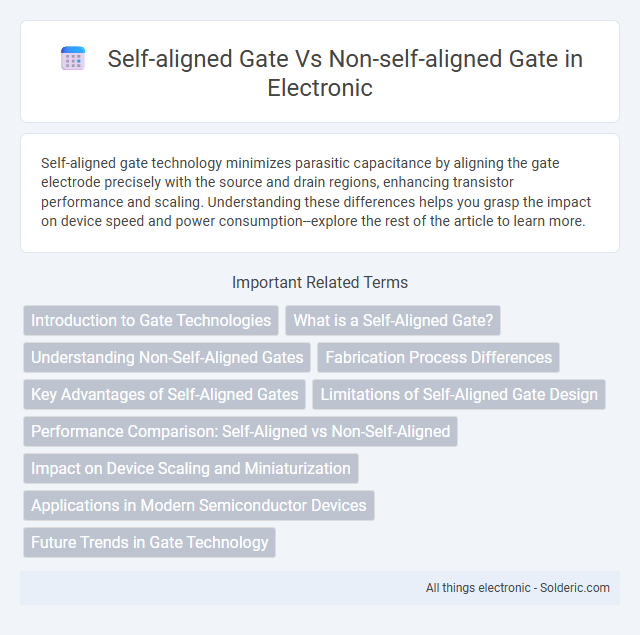Self-aligned gate technology minimizes parasitic capacitance by aligning the gate electrode precisely with the source and drain regions, enhancing transistor performance and scaling. Understanding these differences helps you grasp the impact on device speed and power consumption--explore the rest of the article to learn more.
Comparison Table
| Feature | Self-Aligned Gate | Non-Self-Aligned Gate |
|---|---|---|
| Definition | Gate electrode aligned precisely with source and drain regions | Gate electrode not precisely aligned with source and drain |
| Fabrication | Uses gate as a mask for doping source and drain | Source and drain implanted before gate formation |
| Parasitic Capacitance | Lower parasitic capacitance | Higher parasitic capacitance |
| Device Performance | Improved speed and reduced short-channel effects | Lower speed and pronounced short-channel effects |
| Manufacturing Complexity | More complex fabrication process | Relatively simpler fabrication |
| Applications | Modern CMOS technologies, high-performance ICs | Older technologies, simpler circuits |
| Alignment Accuracy | High accuracy reduces overlap | Lower accuracy results in overlap and leakage |
Introduction to Gate Technologies
Self-aligned gate technology aligns the gate electrode precisely with the source and drain regions, minimizing parasitic capacitances and improving transistor performance in CMOS devices. Non-self-aligned gate processes position the gate independently, often resulting in larger overlap capacitances and reduced device scaling efficiency. Advanced semiconductor fabrication increasingly favors self-aligned gates for enhanced electrical characteristics and reliable nanoscale transistor operation.
What is a Self-Aligned Gate?
A self-aligned gate is a transistor structure in CMOS technology where the gate electrode is used as a mask to precisely align the source and drain regions during fabrication, minimizing parasitic resistances and capacitances. This alignment improves device performance by reducing overlap capacitance and enhancing current drive capability compared to non-self-aligned gates, where source and drain diffusion regions are defined independently, often resulting in larger misalignment and inferior electrical characteristics. Your semiconductor devices benefit from the enhanced precision and scalability offered by self-aligned gate processes, which are critical for high-speed and low-power integrated circuits.
Understanding Non-Self-Aligned Gates
Non-self-aligned gates in MOSFET fabrication lack precise alignment between the gate electrode and source/drain regions, resulting in higher parasitic capacitances and reduced device performance compared to self-aligned gates. This misalignment causes increased overlap capacitance and series resistance, limiting switching speed and power efficiency in integrated circuits. Understanding non-self-aligned gate structures is essential for optimizing device geometry and improving scaling in legacy semiconductor processes.
Fabrication Process Differences
Self-aligned gate technology employs the gate electrode as a mask during the source and drain implantation, ensuring precise alignment that reduces parasitic capacitance and enhances device performance. Non-self-aligned gates require separate lithography steps for the gate and source/drain regions, leading to less accurate alignment and increased overlap capacitance. Your choice between these methods impacts fabrication complexity, yield, and transistor scaling in semiconductor manufacturing.
Key Advantages of Self-Aligned Gates
Self-aligned gates enable precise alignment of the gate electrode with the source and drain regions, significantly reducing parasitic capacitance and improving device performance. This technique enhances channel control in MOSFETs, leading to increased drive current and reduced short-channel effects compared to non-self-aligned gates. Improved manufacturing yield and scalability to smaller technology nodes are additional advantages due to minimized lithographic misalignment issues.
Limitations of Self-Aligned Gate Design
Self-aligned gate designs face limitations such as increased process complexity and challenges in controlling short-channel effects at nanometer scales, which can degrade device performance. Precise alignment is critical, and any misalignment can lead to variability in threshold voltage and drive current, impacting overall reliability. Your circuit performance might be constrained by these issues, especially in advanced technology nodes requiring tighter process control.
Performance Comparison: Self-Aligned vs Non-Self-Aligned
Self-aligned gate technology enhances transistor performance by reducing parasitic capacitance and resistance compared to non-self-aligned gates, resulting in faster switching speeds and improved device scaling. Non-self-aligned gates often suffer from misalignment issues, causing increased overlap capacitance and degraded drive current. Your circuits benefit from the precise alignment in self-aligned gates, which ensures higher performance and greater reliability in advanced semiconductor devices.
Impact on Device Scaling and Miniaturization
Self-aligned gate technology enables precise alignment of the gate electrode with source and drain regions, significantly reducing parasitic capacitances and enabling aggressive device scaling. Non-self-aligned gates suffer from overlap misalignments that increase parasitic resistances and capacitances, limiting miniaturization and degrading overall device performance. The improved electrostatic control and reduced short-channel effects in self-aligned gate transistors make them essential for advanced nanoscale CMOS technologies.
Applications in Modern Semiconductor Devices
Self-aligned gate technology enhances device performance in modern semiconductor devices by minimizing parasitic capacitance and enabling finer feature sizes, crucial for high-speed CMOS transistors in microprocessors and memory chips. Non-self-aligned gate processes, though simpler, often result in larger overlap capacitances that limit scaling and are primarily used in older or less performance-critical integrated circuits. Advanced applications in DRAM and logic devices increasingly rely on self-aligned gates to achieve higher drive currents and improved short-channel control, supporting the continued scaling of semiconductor technology nodes.
Future Trends in Gate Technology
Future trends in gate technology emphasize the transition from non-self-aligned gates to self-aligned gates due to their superior scalability, reduced parasitic capacitance, and enhanced device performance. Self-aligned gates enable tighter control over channel length, which is critical for next-generation transistors in advanced semiconductor nodes below 5 nm. Your ability to leverage self-aligned gate technology will be essential for optimizing power efficiency and improving overall circuit density in emerging integrated circuits.
Self-aligned gate vs Non-self-aligned gate Infographic

 solderic.com
solderic.com